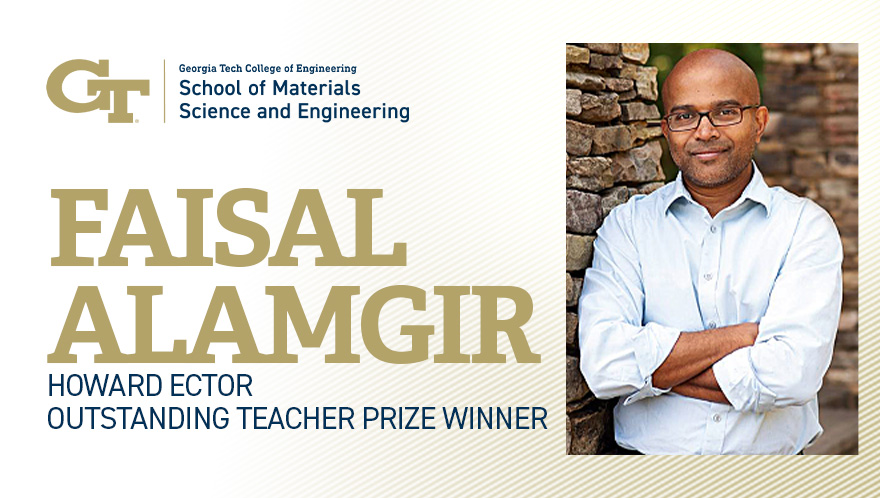
By Yvonne Medina
Dr. Alamgir, who has been teaching in MSE since 2007, recently received the Class of 1940 Howard Ector Outstanding Teacher Prize for his innovative and conceptually rigorous pedagogical methods. This is the top teaching prize awarded by GT and it is the first time in the history of MSE that one of its faculty has been bestowed with this honor.
One of the innovations cited by the awards committee was the creative way Prof. Alamgir intertwined liberal arts approaches to imbue critical thinking among the students in his class. For example, in one of his courses, students wrote short plays, based on the themes learned in his class, and performed them at the DramaTech Theater on campus. This emphasis on translating scientific concepts serves students well in their careers when they must explain these concepts to those inside and outside the scientific community.
Dr. Alamgir insists that he focuses on a deeper understanding of concepts rather than on volume of content. He whittles down a course to about five or six major concepts and charges the students to make deep connections between those concepts. To help students remember as much of the course as possible, he sometimes reviews necessary mathematical concepts at the beginning of the course and frequently refers back to previous concepts as they move through the conceptual groundwork. He describes these motions as occasionally recursive and looping, sometimes “sling shotting forward and back between these concepts.” His focus is on consolidating the information as much as possible so students can carry it forward with them into future courses and their career.
He does not want to be the only source of knowledge in the class, however. Empowering students to own this material enough to translate these scientific concepts to others is a cornerstone of Dr. Alamgir’s pedagogical practice. He tells me, “The level with which you can communicate what you learned tells me how deeply you have learned the material; If you are unable to translate what you learned in layman’s terms then you cannot claim to really know the material.” Therefore, he takes a more liberal arts approach to teaching by testing students on their ability to explain concepts. He tests their ability to narrate and communicate their ideas to others, a valuable skill among scientists who must explain their contributions to stakeholders outside their field. In his exams, he includes questions that must be answered in the form of essays, and he does not allow students to refer to any equations to explain parts of the story. He says, “Students are uncomfortable with the proposition of losing the reference point of packaged knowledge. They can no longer hide behind someone else’s authority. They have to be the authority.” This unusual teaching method ultimately empowers students to become their own authority on a scientific concept instead of relying on other thinkers.
Here is a concrete example of Dr. Alamgir’s teaching philosophy in practice: For Materials Characterization, a foundational course for MSE undergraduates, he asks groups of students to study one of five equations for the entire semester. They must first translate mathematical equations, an abstract symbolic language, into intelligible English. Students are at first confused by this idea, but they quickly become engrossed. The rest of the semester they do a deep dive on the equation; they ask what is its history? How did it enter the scientific community? The geopolitical realities, if relevant, are properly contextualized. In addition, the hidden labor of those who aided these scientists, but whose names have been forgotten to history, are also appreciated in this class.
Next, students draw on their enriched understanding of the very complicated process by which mathematical knowledge was created, knowledge that had previously been hidden behind the symbols of the equations. Dr. Alamgir asks the students to resynthesize the story of the equation; they must come up with a short play that embodies the equation. They can choose any genre, from drama to comedy to historical biopic and surrealism. Some groups decide to embody abstract concepts, take the role of a historical scientist, and imagine the equation’s significance at different points in history. He worked with former Brittain Fellow Dr. Francizska Tsufim to scaffold these concepts, and then students created Playbills and presented their staged equations at Dramatech theater.

[This picture shows one of the Playbills for one such play. The title “Breaking Berg” is a riff on the popular show Breaking Bad, which has a character named after Werner Heisenberg, a scientist critical to the development and proof of the equation that the group was studying.]
Dr. Alamgir’s approach to graduate teaching is also responsive to science’s shifting role in both the workplace and wider media landscape. As a capstone project, his graduate students must make a case for why they need access to a scientific laboratory, a skill akin to grant writing that they will need to practice in their career. This project also leaves them with a template for a real facility proposal. Graduate students also have the opportunity to make a podcast, a highly popular medium for scientific topics. The skills Dr. Alamgir gives his students include both material, hard-won scientific concepts that have stood the test of time, and the ability to own these concepts, embody them, and communicate them to others.